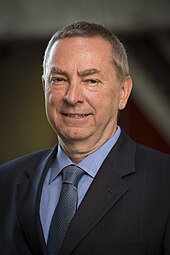Nigel Lockyer
Nigel Lockyer (born November 5, 1952 in Annan , Dumfries and Galloway , Scotland ) is an American experimental particle physicist.
Lockyer studied at York University in Toronto (Downsview), Canada (Bachelor's degree in 1975) and received his doctorate in 1980 from Ohio State University . As a post-doc he was at SLAC until 1984 , where he was spokesman for the Mark II collaboration that investigated the bottom quark . From 1984 he was also Assistant Professor at the University of Pennsylvania , from 1998 as a professor. He was also involved in the planning of experiments on the Superconducting Super Collider , which was discontinued in 1993 (from 1987 to 1993 he was one of the spokesmen for the BCD collaboration (Bottom Collider Detector)) and from 2002 co-spokesman for the CDF collaboration at Fermilab, with which the Top -Quark was examined.
In 2007 he became director of the Canadian TRIUMF accelerator facility and is also a professor at the University of British Columbia . From 2005 he was co-speaker of the Superconducting Module Test Facility (SMTF), an international collaboration of accelerator physicists who develop new techniques for superconducting accelerators (SRF techniques, for superconducting radio frequency).
In addition to working in particle physics, he was also involved in the use of particle accelerators in medicine (proton accelerators for cancer therapy, detectors). In 2006 he received the Panofsky Prize with John Jaros and William T. Ford for the discovery of the abnormally long lifespan of the B-quark at SLAC. In 2000 he became a Fellow of the American Physical Society .
Web links
| personal data | |
|---|---|
| SURNAME | Lockyer, Nigel |
| BRIEF DESCRIPTION | American physicist |
| DATE OF BIRTH | 5th November 1952 |
| PLACE OF BIRTH | Annan, Scotland |
